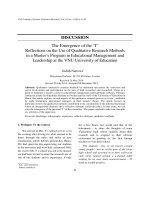Subjects Of Scientific Research Methods Training Program International Physics.pdf
Bạn đang xem bản rút gọn của tài liệu. Xem và tải ngay bản đầy đủ của tài liệu tại đây (781.74 KB, 24 trang )
<span class="text_page_counter">Trang 1</span><div class="page_container" data-page="1">
<small>VIETNAM NATIONAL UNIVERSITYHANOI UNIVERSITY OF SCIENCE</small>
<small>DEPARTMENT OF PHYSICS____ⴰⴰ oOo ⴰⴰ____</small>
<small>STUDENT: LE MINH QUAN</small>
MONTE CARLO SIMULATION FORMAGNETIC MATERIALS
<small>SUBJECTS OF SCIENTIFIC RESEARCH METHODSTRAINING PROGRAM: INTERNATIONAL PHYSICS</small>
<small>SUPERVISORS: Assoc. Prof. Dr. BACH HUONG GIANG PG. NGUYEN HAI PHONG</small>
<small>HANOI, 01/2023</small>
</div><span class="text_page_counter">Trang 2</span><div class="page_container" data-page="2">VIETNAM NATIONAL UNIVERSITYHANOI UNIVERSITY OF SCIENCE
</div><span class="text_page_counter">Trang 3</span><div class="page_container" data-page="3">First of all, I would like to give my thanks to Assoc. Prof.Bach Huong Giang for guiding and helping me in the process ofresearching and finishing this topic. And a special thanks must beextended to the Postgraduate Nguyen Hai Phong who was alwaysavailable for invaluable discussion, advice and assistance. Myclassmate Nguyen Dinh Tien also helped me in sharing hisexpertise with regards this report. With their assistances, I foundmyself making a lot of progress in my reading and researchingskills. This will be an indispensable baggage in the path of myeducation and research.
<small>Regards, Hanoi, January 13, 2023</small>
<small> </small>Le Minh Quan
</div><span class="text_page_counter">Trang 4</span><div class="page_container" data-page="4">1.6. Sampling and Averaging...12
1.7. Monte Carlo method...16
1.8. Calculation of observables – the quantities have to measure in a system of magnetic material...16
</div><span class="text_page_counter">Trang 5</span><div class="page_container" data-page="5">1. THEORY
1.1. General Introduction
Magnetic material has been found for the mileniums,and by around 300 - 200 B.C, humans had created one of thefirst devices to apply magnetism – the compass. With themagnetic properties of materials, human history has seenmany major turning points. Humans have applied materialsto form magnetic components used in many devices for dailylife such as fans, televisions, refrigerators, etc.
To meet the increasing application of magneticmaterials in life. Human have developed the discipline ofmagnetism to study the properties and phenomena ofmagnetic materials. Among the phenomena of magneticmaterials, there is a phenomenon that has received muchattention from the scientific community, which is the phasetransition of magnetic materials. From the classical Langevintheory (1905) on the research work on paramagnetism anddiamagnetism, or the model of molecular field theory ofWeiss (1907) explaining the phenomenon of ferromagnetismare famous theories, typical of magnetic material research.And in 1925, Ernst Ising published his doctoral thesis in theform of a scientific report.
</div><span class="text_page_counter">Trang 6</span><div class="page_container" data-page="6">1.2. Aims of achievement
This discussion serves as an introduction to the use ofMonte Carlo simulations as a useful way to evaluate theobservables of a ferromagnet. Key background is givenabout the relevance and effectiveness of this stochasticapproach and in particular the applicability of theMetropolis-Hastings algorithm. Importantly the potentiallydevastating effects of spontaneous magnetization arehighlighted and a means to avert this is examined.
An Ising model is introduced and used to investigate theproperties of a two dimensional ferromagnet with respect toits magnetization and energy at varying temperatures. Theobservables are calculated and a phase transition at a criticaltemperature is also illustrated and evaluated. Lastly a finitesize scaling analysis is undertaken to determine the criticalexponents and the Curie temperature is calculated using aratio of cumulants with differing lattice sizes. The resultsobtained from the simulation are compared to exactcalculations to endorse the validity of this numerical process.In this research experiment, I relied on J. Kotze’s articlebecause I read and realized it is very detailed. From thereason why we have to do this work, find the solutions ofobservables, to the way to solve the problem.
1.3. Background
In most ordinary materials the associated magneticdipoles of the atoms have a random orientation. In effect this
</div><span class="text_page_counter">Trang 7</span><div class="page_container" data-page="7">non-specific distribution results in no overall macroscopicmagnetic moment. However in certain cases, such as iron, amagnetic moment is produced as a result of a preferredalignment of the atomic spins.
This phenomenon is based on two fundamentalprinciples, namely energy minimization and entropymaximization. These are competing principles and areimportant in moderating the overall effect. Temperature isthe mediator between these opposing elements andultimately determines which will be more dominant.
The relative importance of the energy minimization andentropy maximization is governed in nature by a specificprobability
(1)which is illustrated in figure below
Figure 1: Boltzmann probability distribution as a landscapefor varying Energy (E) and Temperature (T ).
</div><span class="text_page_counter">Trang 8</span><div class="page_container" data-page="8">1.4. Model
To understand this theory, we need to clearly understandthe spin and magnetic moment. These factors prove to beunnecessary complications.
So the central idea to a model is to simplify thecomplexity of the problem to such a degree that it ismathematically tractable to deal with while retaining theessential physics of the system. The Ising Model does thisvery effectively and even allows for a good conceptualunderstanding.
In this report, I will present the Ising 2D model. This isthe mathematical model of ferromagnet in statisticalmechanic.
Figure 2: A lattice illustration of model Ising 2D
An Ising model describes the interaction between spinsplaced in the juntions of a lattice d-dimensions. With asystem of spin S = ½, the quantum values of it on the z-axisare just one of 2 states “up” or “down” (+1/2 or -1/2). This isone of the simplest statistical model to describe the phasetransition of the ferromagnet.
</div><span class="text_page_counter">Trang 9</span><div class="page_container" data-page="9">We will consider a 2D squared lattice have size L andthe total spins N = L x L. Thus, a simplest classical Isingmodel is decribed by a Hamiltonian in the form (2) below:
s<small>i</small> and s : value of spin at position i and j<small>j</small>
The reason why we set the J larger of smaller than 0dues to the direction of spin i and spin j, when spin i and jhave the same direction, assume positive and negative spinhave value +1 and -1, it means that energy of the system issum of 4 value of summation of multiplication between spini and j and equal 4, with the minus sign of Hamiltonian,energy of system equal −4, so we set J>0 for parallel link tolet energy smallest, similar for the case spin i have oppositedirection with spin j, so J<0 for anti-parallel link to satisfythe minimization energy.
For simple, I will stipulate that J = +1 (take the exampleof ferromagnet), spins +1 for spin “up” and -1 for spin“down” and J/k is taken to be unity. Thus, we get the<small>b</small>
relative position of the nearest neighbor of spins
</div><span class="text_page_counter">Trang 10</span><div class="page_container" data-page="10">Figure 3: Nearest neighbor coupling
With dark dot is the position spin s considering,<small>i</small>
surrounding spins are the nearest neighbor s of spin s . We<small>ji</small>
can see that for a spin, there’re 4 nearest neighborsurrounding it. But what if the spin is in the edge?
The answer is to maximize the interaction, those spinsare made to interact with the spins at the geometric oppositeedges of the lattice. This is referred to as periodic boundarycondition (pbc) and can be visualized better if we considerthe 2D lattice being folded into a donut-shaped 3D withspins being on the surface of this topological structure.
</div><span class="text_page_counter">Trang 11</span><div class="page_container" data-page="11">Figure 4: An illustration of a donut-shaped 3D which isrepresentative of a 2D lattice with periodic boundary
1.5. Computational problems
With the help of Ising model, we can anticipate thesolutions of observables. For a possible state α, theBoltzmann distribution function, equation (1) will be:
Thus, the macroscopic quantities of interest can becalculated by doing probability summing.
For example, for any fix state α, the magnetization willbe the different between the summation of spins “up” minussummation of spins “down”.
M (α)= N
<sub>up</sub>(α)− N
<sub>down</sub>(α)
(3)while energy of lattice will be the Hamiltonian above,equation (2).E
<sub>i</sub>=H
<sub>i</sub>=−J ∑
s
<sub>i</sub>s
<sub>j</sub></div><span class="text_page_counter">Trang 12</span><div class="page_container" data-page="12">The expected value M and E is given by
⟨ M ⟩= ∑<sub>α</sub> M (α) P(α)
(4)
⟨ E ⟩= ∑<sub>α</sub> E(α) P(α)
(5)The problem of these calculations is, when we use them,in N spins lattice there are 2 different states. That means the<small>N </small>
computations become so difficult with N large.
It may seem a natural suggestion to use a computersimulation to do these calculations but by examiningequations (4) and (5) more closely it becomes apparent thatusing this procedure would waste as much computing efforton calculating an improbable result as it does on a veryprobable result. Thus a better numerical alternative would beto use a simulation to generate data over the ‘representativestates’. These representative states constitute the appropriateproportions of different states. This is a form of biasedsampling which essentially boils down to satisfying thecondition
GENERATED FREQUENCY ≡ ACTUAL PROBABILITY(computer) (theory)
With that condition, we now need to examine how to accomplish the objective.
1.6. Sampling and Averaging
The thermal average for an observable A(x) is defined in thecanonical ensemble
</div><span class="text_page_counter">Trang 13</span><div class="page_container" data-page="13">⟨ E ⟩=<sup>1</sup>
2⟨−J ∑
= ⟨ A
<small>2</small>⟩− ⟨A⟩
<sup>2</sup> we can calculate the heat capacity C and susceptibility χ.C=<sup>∂ E</sup>∂T<sup>=</sup>
(Δ )E
<small>2</small>k
<sub>b</sub>T<sup>=</sup>
</div><span class="text_page_counter">Trang 14</span><div class="page_container" data-page="14">Figure 5: Metropolis Flowchart
<small>•</small> In the first step the lattice is INITIALIZED to a starting configuration. This may either be a homogeneous or random configuration. A random configuration has a benefit in that it uses less computing time to reach a equilibrated configuration with the associated heat bath.
</div><span class="text_page_counter">Trang 15</span><div class="page_container" data-page="15">• In the following PROCESS the random number generator is used to select a position on the lattice by producing a uniformly generated number between 1 andN.
• A DECISION is then made whether the change in energy of flipping that particular spin selected is lower than zero. This is in accordance with the principle of energy minimization.
– If the change in energy is lower than zero then a PROCESS is invoked to flip the spin at the selected site and the associated change in the observables that want to be monitored are stored.– If the change in energy is higher than zero then aDECISION has to be used to establish if the spin is going to be flipped, regardless of the higher energy consideration. A random number is generated between 0 and 1 and then weighed against the Boltzmann Probability factor. If the random number is less than the associated probability, e<small>-βδH</small>, then the spin is flipped (This would allow for the spin to be flipped as a result of energy absorbed from the heat bath, as in keeping with the principle of entropy maximization) else it is left unchanged in its original configuration.
<small>•</small> The above steps are repeated N times and checked at this point in a DECISION to determine if the loop is
</div><span class="text_page_counter">Trang 16</span><div class="page_container" data-page="16">completed. The steps referred to here do not include the initialization which is only required once in the beginning of the algorithm.
• Once the N steps are completed a PROCESS is used to add all the progressive changes in the lattice
configuration together with the original configuration inorder to produce a new lattice configuration.
• All these steps are, in turn, contained within a Monte Carlo loop. A DECISION is used to see if these steps are completed.
• Once the Monte Carlo loop is completed the program is left with, what amounts to, the sum of all the generated lattices within the N loops. A PROCESS is thus employed to average the accumulated change in observables over the number of spins and the number ofMonte Carlo steps.
• Lastly this data can be OUTPUT to a file or plot.
1.10. Run program
In this time, we will run the program for the samplewithout external field, take care of the observables: ‹E›,‹ › ‹E<small>2</small>, M∣ ∣› and ‹M<small>2</small>›.
Run through the algorithm produces a set of observablesfor a specific temperature. Considering that we are interestedin seeing a phase transition with respect to temperature, weneed to contain this procedure within a temperature loop in
</div><span class="text_page_counter">Trang 17</span><div class="page_container" data-page="17">order to produce these observables for a range oftemperature.Take the temperature T start from 1 to 5 withintervals of 0.1.
Consider lattice sizes N = 2 × 2 ; 4 × 4 ; 8 × 8 ; 16 × 16.Run 5.000.000 Monte Carlo steps, thow away 3.000.000steps, each 100.000 steps write out 1 time.
The steep gradient in the larger lattices points towards apossible phase transition but isn’t clearly illustrated.
</div><span class="text_page_counter">Trang 18</span><div class="page_container" data-page="18">The energy per spin for higher temperatures is relativelyhigh. This is in keeping with our expectation of having arandom configuration while it stabilizes to a E/N = −2J = −2at low temperatures. This indicates that the spins are allaligned in parallel. In the region of low temperature T < 2,energy of the lattice keeps stable ,and rapidly increases whentemperature increase T > 2
When the Temperature increases T > 2, the spinsfluctuate lead to rapidly reduced the magnetization of thelattice.
Decrease in magnetization of the larger lattices is fasterthan the smaller ones evidently due to the size of the lattices.With the small lattices, change of the spins not as clear as the
</div><span class="text_page_counter">Trang 19</span><div class="page_container" data-page="19">larger ones, leads to the decrease of magnetization slowerthan the larger lattices.
In the explaination of this phenomenon, because themagnetization is determined by excess of the spins, in thelow temperature, spins are parallel align with the samedirection to satisfy the minimization energy, so we have thelargest magnetization due to the equation (3) and (4). Andwith the temperature increasing, the spins are unstable, theyflip continously and nonstop. This destroy the internalmagnetization of sample, lead to the magnetization very low,can be considered as insignificant.
</div><span class="text_page_counter">Trang 20</span><div class="page_container" data-page="20">We concluded previously that a divergence would occurat a phase transition and thus should be looking for such adivergence on the graph. It is however clear that there is nosuch divergence but merely a progressive steepening of thepeak as the lattice size increases. The point at which the plotis peaked will be noted as a possible point of divergence.
2.4. Susceptibility
With the susceptibility of sample, we will get a problemthat is our simulating susceptibility give out the data thus notexactly equivalent to the theoretical susceptibility, χ. So, todistinguish these 2 quantities, we call the simulationsusceptibility is χ’.
The scaling characteristic of this susceptibility is,however, equivalent to the theoretical value and only variesby a constant factor above the Curie temperature.
</div><span class="text_page_counter">Trang 21</span><div class="page_container" data-page="21">Graph 4: The differing results of the theoreticalsusceptibility for varying lattice sizes, L × L
Graph 5: The differing results of the simulationsusceptibility for varying lattice sizes, L × L
</div><span class="text_page_counter">Trang 22</span><div class="page_container" data-page="22">For the small size lattice, the simulate susceptibility χ’have the peak far away from the supposed Curie temperatureabove. But for the large size L = 16, the sharp peak should bestrong evidence eluding to a second order phase transition.
A comparison can be made between χ′ and χ in graph 4 and 5 respectively. It is clear that a marked difference in results occurs. This mistake becomes even more evident if you were to use to get the critical exponent using finite size scaling. Only χ′ produces the correct finite size scaling.
go to zero when T > T . Indeed, the simulation result<small>c</small>
consistent with the theory, we can see the change in theinterval T from 2 to 2.5. We also get the similar result in〈 〉E .
Next, we have observed the peak in the graph HeatCapacity C depend on Temperature T. Change of thetemperature in this graph is also the same as change oftemperature in magnetization graph and energy graph.
From the indications of variation around a temperaturerange T of observables, we can guess that the 2D spin model
</div>








